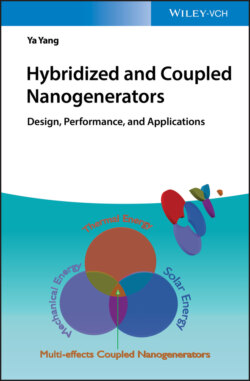Читать книгу Hybridized and Coupled Nanogenerators - Ya Yang - Страница 27
2.3.1.1 Vibrating Plate‐Based TENGs
ОглавлениеYang et al. proposed vibrating plate‐based TENGs to harvest wind energy in our daily living environment, which consists of two aluminum (Al) foils and a fluorinated ethylene‐propylene (FEP) film in a rectangular acrylic tube, as shown in Figure 2.2a [32]. The Al foils were stuck on the upper and lower ends, which can be used as both electrodes and triboelectric surfaces. To vibrate along with the wind, one side of the FEP film was clamped to the rectangular acrylic tube. The periodic contact between the FEP film and the Al foils can generate an output current across an external circuit. The side view of the fabricated plate‐based TENG shows that the device is light and handy (Figure 2.2b). Figure 2.2c shows the front view of the device.
Figure 2.2 Diagram of the plate‐based TENG. (a) Schematic diagram of the TENG. (b,c) The side and front views of the TENG.
Source: Reproduced with permission from Yang et al. [32]. Copyright 2013, American Chemical Society.
The working mechanism of the plate‐based TENG is schematically represented in Figure 2.3. At the initial state, contact between the surface of the Al foil and the FEP film led to electrons transfer from Al to FEP, resulting in positive charges on the surface of the Al foil and negative charges on the surface of the FEP. There is no current in the external circuit because the positive and negative triboelectric charges balance each other (Figure 2.3a). When the FEP film segregates the bottom Al foil due to wind‐induced vibration the balance is destroyed, leading to the opposite current at the two Al foils (Figure 2.3b). The electrostatic‐induced current will be maintained consistently until the negative triboelectric charges on the FEP film are completely screened from the positive charges, where the current signals disappear at the foils, as shown in Figure 2.3c. Subsequently, the FEP film was close to the bottom Al foil, leading the influent and the effluent current signals to the top and the bottom Al foils, respectively, as depicted in Figure 2.3d. This process finishes once the FEP film makes contact with the bottom Al foil due to the balance formed between them, as shown in Figure 2.3e. Figure 2.3f illustrates that the FEP film is close to the top Al foil, leading to the opposite current signals compared with those in Figure 2.3d. Consequently, plate‐based TENG, which can be driven between the two Al electrodes under vibration situation, can be used to harvest wind energy.
